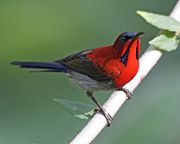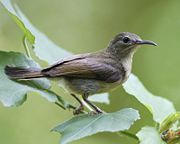Sunbird
| Sunbirds and spiderhunters | ||||||||||||
|---|---|---|---|---|---|---|---|---|---|---|---|---|
  Crimson Sunbird (male above, female below)
|
||||||||||||
| Scientific classification | ||||||||||||
|
||||||||||||
| Genera | ||||||||||||
|
15, see text |
The sunbirds and spiderhunters are a family, Nectariniidae, of very small passerine birds. There are 132 species in 15 genera. The family is distributed throughout Africa, southern Asia and just reaches northern Australia. Most sunbirds feed largely on nectar, although they will also take insects, especially when feeding young. Fruit is also part of the diet of some species. Their flight is fast and direct on their short wings.
The sunbirds have counterparts in two very distantly related groups: the hummingbirds of the Americas and the honeyeaters of Australia. The resemblances are due to convergent evolution due to the similar nectar-feeding lifestyle.[1] Some sunbird species can take nectar by hovering like a hummingbird, but usually perch to feed.
Contents |
Description
The family ranges in size from the 5-gram Black-bellied Sunbird to the Spectacled Spiderhunter, at about 30 grams. Like the hummingbirds, sunbirds are strongly sexually dimorphic, with the males usually brilliantly plumaged in metallic colours.[2] In addition to this the tails of many species are longer in the males, and overall the males are larger. Sunbirds have long thin down-curved bills and brush-tipped tubular tongues, both adaptations to their nectar feeding.[3] The spiderhunters, of the genus Arachnothera, are distinct in appearance from the other members of the family. They are typically larger than the other sunbirds, with drab brown plumage and strong down-curved beaks.
Species of sunbirds that live in high altitudes will enter torpor while roosting at night, lowering their body temperature and entering a state of low activity and responsiveness.[2][4]
Distribution and habitat
Sunbirds are tropical species, with representatives from Africa to Australasia; the greatest variety of species is in Africa, where the group probably arose. Most species are sedentary or short-distance seasonal migrants. The sunbirds occur over the entirely of the family's range, whereas the spiderhunters are restricted to Asia.
The sunbirds and spiderhunters occupy a wide range of habitats, with a majority of species being found in primary rainforest, but other habitats used by the family including disturbed secondary forest, open woodland, open scrub and savannah, coastal scrub and alpine forest. Some species have readily adapted to human modified landscapes such as plantations, gardens and agricultural land. Many species are able to occupy a wide range of habitats from sea level to 4900 m.
Behaviour
Sunbird are active diurnal birds that generally occur in pairs or occasionally in small family groups. A few species occasionally gather in larger groups, and sunbird will join with other birds to mob potential predators, although sunbirds will also aggressively target other species, even if they are not predators, when defending their territories.
They are generally monogamous and often territorial, although a few species of sunbirds have lekking behaviour. Up to three eggs are laid in a purse-shaped suspended nest. The female builds the nest and incubates the eggs alone, although the male assists in rearing the young after hatching.[5] The spiderhunters build cup-shaped nests, and both sexes help to incubate the eggs.[5] The nests of sunbirds and spiderhunters are often targeted by brood parasites such as cuckoos and honeyguides.
Relationship with humans
Overall the family has fared better than many others, with only seven species considered to be threatened with extinction. Most species are fairly resistant to changes in habitat, and while attractive the family is not sought after by the cagebird trade, as they have what is considered an unpleasant song and are tricky to keep alive. Sunbirds are considered attractive birds and readily enter gardens where flowering plants are planted to attract them. There are a few negative interactions, for example the Scarlet-chested Sunbird is considered a pest in cocoa plantations as it spreads parasitic mistletoes.
Systematics
- FAMILY NECTARINIIDAE
- Genus Chalcoparia (sometimes included in Anthreptes)
- Ruby-cheeked Sunbird, Chalcoparia singalensis
- Genus Deleornis (sometimes included in Anthreptes)
- Scarlet-tufted Sunbird, Deleornis fraseri
- Grey-headed Sunbird, Deleornis axillaris - sometimes included in D. fraseri
- Genus Anthreptes (c.12 species)
- Genus Hedydipna (sometimes included in Anthreptes)
- Collared Sunbird, Hedydipna collaris
- Pygmy Sunbird, Hedydipna platura
- Nile Valley Sunbird, Hedydipna metallica
- Amani Sunbird, Hedydipna pallidigaster
- Genus Hypogramma
- Purple-naped Sunbird, Hypogramma hypogrammicum
- Genus Anabathmis (sometimes included in Nectarinia)
- Reichenbach's Sunbird, Anabathmis reichenbachii
- Principe Sunbird, Anabathmis hartlaubii
- Newton's Sunbird, Anabathmis newtonii
- Genus Dreptes (sometimes included in Nectarinia)
- Sao Tome Sunbird, Dreptes thomensis
- Genus Anthobaphes - Orange-breasted Sunbird (sometimes included in Nectarinia)
- Genus Cyanomitra (sometimes included in Nectarinia)
- Green-headed Sunbird, Cyanomitra verticalis
- Blue-throated Brown Sunbird, Cyanomitra cyanolaema
- Blue-headed Sunbird, Cyanomitra alinae
- Cameroon Sunbird, Cyanomitra oritis
- Bannerman's Sunbird, Cyanomitra bannermani
- Eastern Olive Sunbird, Cyanomitra olivacea
- Western Olive Sunbird, Cyanomitra obscura
- Mouse-coloured Sunbird, Cyanomitra veroxii
- Genus Chalcomitra (sometimes included in Nectarinia)
- Buff-throated Sunbird, Chalcomitra adelberti
- Carmelite Sunbird, Chalcomitra fuliginosa
- Green-throated Sunbird, Chalcomitra rubescens
- Amethyst Sunbird, Chalcomitra amethystina
- Scarlet-chested Sunbird, Chalcomitra senegalensis
- Hunter's Sunbird, Chalcomitra hunteri
- Socotra Sunbird, Chalcomitra balfouri
- Genus Leptocoma (sometimes included in Nectarinia)
- Purple-rumped Sunbird, Leptocoma zeylonica
- Crimson-backed Sunbird, Leptocoma minima
- Copper-throated Sunbird, Leptocoma calcostetha
- Purple-throated Sunbird, Leptocoma sperata
- Black Sunbird, Leptocoma sericea - formerly Nectarinia aspasia
- Genus Nectarinia (8 species in the strict sense)
- Bocage's Sunbird, Nectarinia bocagii
- Purple-breasted Sunbird, Nectarinia purpureiventris
- Tacazze Sunbird, Nectarinia tacazze
- Bronze Sunbird, Nectarinia kilimensis
- Golden-winged Sunbird, Nectarinia reichenowi
- Red-tufted Sunbird, Nectarinia johnstoni
- Malachite Sunbird, Nectarinia famosa
- (the Orange-breasted Sunbird, Anthobaphes violacea, is sometimes included in the Necarinia.)
- Genus Cinnyris (sometimes included in Nectarinia)
- Olive-bellied Sunbird, Cinnyris chloropygius
- Tiny Sunbird, Cinnyris minullus
- Miombo Sunbird, Cinnyris manoensis
- Southern Double-collared Sunbird, Cinnyris chalybeus
- Neergaard's Sunbird, Cinnyris neergaardi
- Stuhlmann's Sunbird, Cinnyris stuhlmanni - sometimes included in C. afer
- Prigogine's Sunbird, Cinnyris prigoginei - sometimes included in C. afer
- Montane Double-collared Sunbird, Cinnyris ludovicensis - sometimes included in C. afer
- Northern Double-collared Sunbird, Cinnyris preussi
- Greater Double-collared Sunbird, Cinnyris afer
- Regal Sunbird, Cinnyris regius
- Rockefeller's Sunbird, Cinnyris rockefelleri
- Eastern Double-collared Sunbird, Cinnyris mediocris
- Moreau's Sunbird, Cinnyris moreaui
- Beautiful Sunbird, Cinnyris pulchellus
- Loveridge's Sunbird, Cinnyris loveridgei
- Mariqua Sunbird, Cinnyris mariquensis
- Shelley's Sunbird, Cinnyris shelleyi
- Congo Sunbird, Cinnyris congensis
- Red-chested Sunbird, Cinnyris erythrocerca
- Black-bellied Sunbird, Cinnyris nectarinioides
- Purple-banded Sunbird, Cinnyris bifasciatus
- Tsavo Sunbird, Cinnyris tsavoensis - sometimes included in C. bifasciatus
- Violet-breasted Sunbird, Cinnyris chalcomelas
- Pemba Sunbird, Cinnyris pembae
- Orange-tufted Sunbird, Cinnyris bouvieri
- Palestine Sunbird, Cinnyris oseus
- Shining Sunbird, Cinnyris habessinicus
- Splendid Sunbird, Cinnyris coccinigaster
- Johanna's Sunbird, Cinnyris johannae
- Superb Sunbird, Cinnyris superbus
- Rufous-winged Sunbird, Cinnyris rufipennis
- Oustalet's Sunbird, Cinnyris oustaleti
- White-breasted Sunbird, Cinnyris talatala
- Variable Sunbird, Cinnyris venustus
- Dusky Sunbird, Cinnyris fuscus
- Ursula's Sunbird, Cinnyris ursulae
- Bates' Sunbird, Cinnyris batesi
- Copper Sunbird, Cinnyris cupreus
- Purple Sunbird, Cinnyris asiaticus
- Olive-backed Sunbird, Cinnyris jugularis
- Apricot-breasted Sunbird, Cinnyris buettikoferi
- Flame-breasted Sunbird, Cinnyris solaris
- Souimanga Sunbird, Cinnyris sovimanga
- Seychelles Sunbird, Cinnyris dussumieri
- Madagascar Sunbird, Cinnyris notatus
- Humblot's Sunbird, Cinnyris humbloti
- Anjouan Sunbird, Cinnyris comorensis
- Mayotte Sunbird, Cinnyris coquerellii
- Long-billed Sunbird, Cinnyris lotenius
- Genus Aethopyga
- Gray-hooded Sunbird, Aethopyga primigenia
- Mount Apo Sunbird, Aethopyga boltoni
- Lina's Sunbird, Aethopyga linaraborae
- Flaming Sunbird, Aethopyga flagrans
- Metallic-winged Sunbird, Aethopyga pulcherrima
- Elegant Sunbird, Aethopyga duyvenbodei
- Lovely Sunbird, Aethopyga shelleyi
- Handsome Sunbird, Aethopyga belli
- Gould's Sunbird, Aethopyga gouldiae
- White-flanked Sunbird, Aethopyga eximia
- Green-tailed Sunbird, Aethopyga nipalensis
- Fork-tailed Sunbird, Aethopyga christinae
- Black-throated Sunbird, Aethopyga saturata
- Western Crimson Sunbird, Aethopyga vigorsii - sometimes included in A. siparaja
- Crimson Sunbird, Aethopyga siparaja
- Scarlet Sunbird, Aethopyga mystacalis
- Temminck's Sunbird, Aethopyga temminckii - sometimes included in A. mystacalis
- Fire-tailed Sunbird, Aethopyga ignicauda
- Genus Arachnothera - spiderhunters (10-11 species)
Gallery
References
- ↑ Prinzinger, R.; Schafer T. & Schuchmann K. L. (1992). "Energy metabolism, respiratory quotient and breathing parameters in two convergent small bird species : the fork-tailed sunbird Aethopyga christinae (Nectariniidae) and the chilean hummingbird Sephanoides sephanoides (Trochilidae)". Journal of thermal biology 17 (2): 71-79.
- ↑ 2.0 2.1 Cheke, Robert; Mann, Clive (2008), "Family Nectariniidae (Sunbirds)", in Josep, del Hoyo; Andrew, Elliott; David, Christie, Handbook of the Birds of the World. Volume 13, Penduline-tits to Shrikes, Barcelona: Lynx Edicions, pp. 196-243, ISBN 978-84-96553-45-3
- ↑ Cade, Tom; Lewis Greenwald (1966). "Drinking Behavior of Mousebirds in the Namib Desert, Southern Africa" (PDF). Auk 83 (1).
- ↑ Downs, Colleen; Mark Brown (2002). "Nocturnal Heterothermy And Torpor In The Malachite Sunbird (Nectarinia famosa)". Auk 119 (1): 251-260. doi:10.1642/0004-8038(2002)119[0251:NHATIT]2.0.CO;2.
- ↑ 5.0 5.1 Lindsey, Terence (1991). Forshaw, Joseph. ed.. Encyclopaedia of Animals: Birds. London: Merehurst Press. pp. 207. ISBN 1-85391-186-0.
External links
- Sunbird videos on the Internet Bird Collection